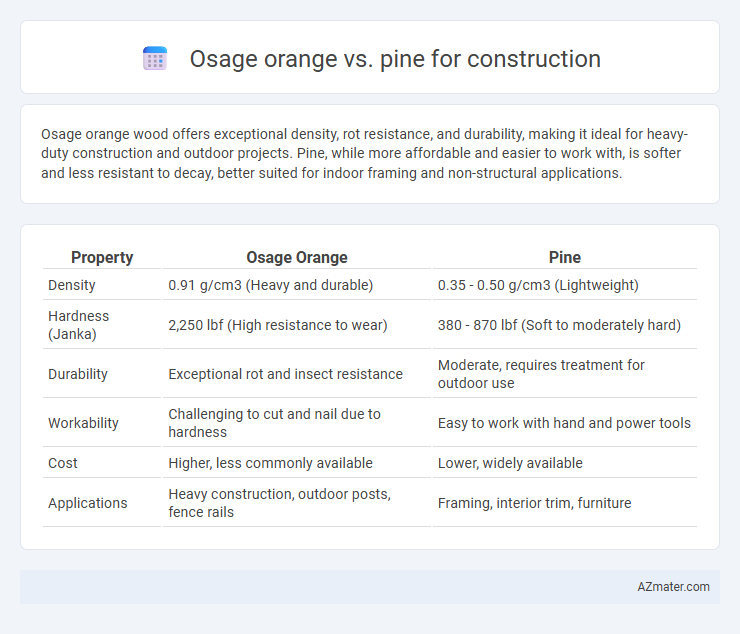Osage orange wood offers exceptional density, rot resistance, and durability, making it ideal for heavy-duty construction and outdoor projects. Pine, while more affordable and easier to work with, is softer and less resistant to decay, better suited for indoor framing and non-structural applications.
Table of Comparison
| Property | Osage Orange | Pine |
|---|---|---|
| Density | 0.91 g/cm3 (Heavy and durable) | 0.35 - 0.50 g/cm3 (Lightweight) |
| Hardness (Janka) | 2,250 lbf (High resistance to wear) | 380 - 870 lbf (Soft to moderately hard) |
| Durability | Exceptional rot and insect resistance | Moderate, requires treatment for outdoor use |
| Workability | Challenging to cut and nail due to hardness | Easy to work with hand and power tools |
| Cost | Higher, less commonly available | Lower, widely available |
| Applications | Heavy construction, outdoor posts, fence rails | Framing, interior trim, furniture |
Introduction to Osage Orange and Pine Wood
Osage orange wood is highly valued for its exceptional density, strength, and natural resistance to decay and insect damage, making it a durable choice for construction projects requiring longevity and toughness. Pine wood, widely abundant and cost-effective, offers ease of workability with good strength-to-weight ratio but generally requires treatment to improve its resistance to moisture and pests. Both woods serve distinct roles in construction, with Osage orange favored for outdoor and heavy-duty applications, while pine is commonly used for framing, paneling, and interior finishes.
Botanical and Physical Characteristics
Osage orange (Maclura pomifera) wood is renowned for its exceptional density, hardness, and natural rot resistance, making it ideal for durable construction projects requiring longevity and strength. Pine, primarily from Pinus species, offers lighter, more workable timber with moderate strength but less natural resistance to decay, necessitating treatment for outdoor or heavy-duty applications. Botanically, Osage orange is a member of the Moraceae family with a distinct yellow-orange heartwood rich in natural preservatives, while pine belongs to the Pinaceae family, characterized by a softer wood grain and prominent resin canals influencing its physical performance.
Strength and Durability Comparison
Osage orange wood exhibits exceptional strength and high density, making it highly resistant to wear, decay, and insect damage, which contributes to its superior durability in construction. Pine, while easier to work with and more widely available, has a softer texture and lower density, resulting in less durability and higher susceptibility to dents and rot over time. For structural applications requiring longevity and resilience, Osage orange outperforms pine by providing enhanced mechanical strength and long-term durability in various environmental conditions.
Resistance to Decay and Insects
Osage orange wood offers superior resistance to decay and insect damage due to its high natural oil content, making it highly durable for construction projects exposed to harsh environmental conditions. Pine, while more widely available and easier to work with, lacks the same level of natural resistance, often requiring chemical treatments to prevent rot and insect infestation. For long-lasting structural applications, Osage orange outperforms pine by maintaining integrity and reducing maintenance costs over time.
Workability and Ease of Processing
Osage orange wood is extremely dense and hard, making it difficult to machine but offering superior durability and resistance to decay, ideal for heavy-duty construction components requiring longevity. Pine, on the other hand, is much softer and easier to cut, shape, and fasten, allowing for faster construction and simpler processing but with less natural durability and strength. Woodworkers often prefer pine for ease of handling and finishing, while Osage orange is chosen when hardness and wear resistance are critical.
Availability and Cost Factors
Osage orange is less commonly available than pine, leading to higher costs and limited sourcing options in construction projects. Pine is widely accessible and more affordable due to its rapid growth and extensive commercial plantations worldwide. Builders often select pine for cost-efficiency and supply consistency, while Osage orange's durability and density justify its premium price in specialized applications.
Environmental Impact and Sustainability
Osage orange wood offers exceptional durability and natural resistance to pests, reducing the need for chemical treatments and lowering environmental impact compared to pine, which requires regular maintenance and treatments. Pine forests are faster-growing and more renewable, making pine a more sustainable choice for large-scale construction projects despite its lower lifespan. Choosing Osage orange combines longevity and minimal chemical use, while pine supports quicker replenishment and carbon sequestration in managed forests.
Common Construction Applications
Osage orange offers exceptional durability and resistance to decay, making it ideal for outdoor construction applications like fence posts, railroad ties, and heavy-duty beams. Pine is widely used in framing, flooring, and interior finishing due to its ease of workability, availability, and cost-effectiveness. While Osage orange provides superior strength and longevity for structural components exposed to harsh conditions, pine is preferred for general construction where budget and versatility are primary considerations.
Aesthetic Differences in Finished Projects
Osage orange wood exhibits a unique golden-orange hue with a fine, tight grain that enhances visual appeal in finished projects, contrasting sharply with pine's lighter, often pale yellow to creamy shade featuring a more pronounced, knotty texture. The durability and density of Osage orange contribute to a smooth, polished finish that ages gracefully, whereas pine tends to show wear more quickly with softer surfaces that can dent or scratch. In construction, selecting Osage orange offers a richer, more distinctive aesthetic ideal for statement pieces, while pine provides a rustic, traditional look suited for casual, cost-effective builds.
Pros and Cons: Osage Orange vs Pine
Osage orange is highly valued in construction for its exceptional durability, strength, and natural resistance to rot and insects, making it ideal for outdoor and load-bearing applications. Pine is more affordable and easier to work with due to its softer texture and lower density but is less durable and more susceptible to decay and insect damage unless treated. While Osage orange offers superior longevity and structural integrity, pine provides cost-effective versatility and quicker installation, influencing material choice based on project requirements and budget.

Infographic: Osage orange vs Pine for Construction
 azmater.com
azmater.com